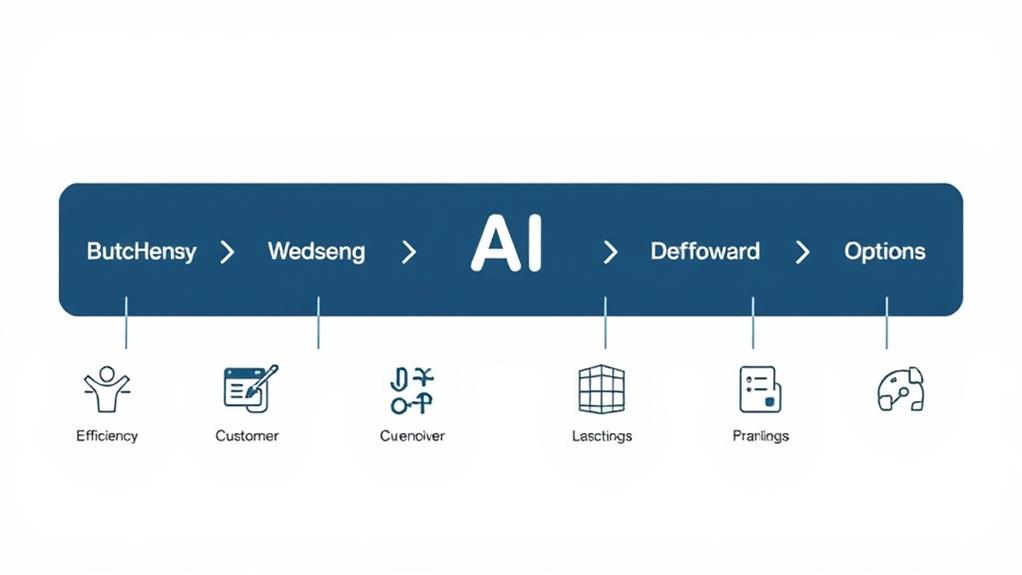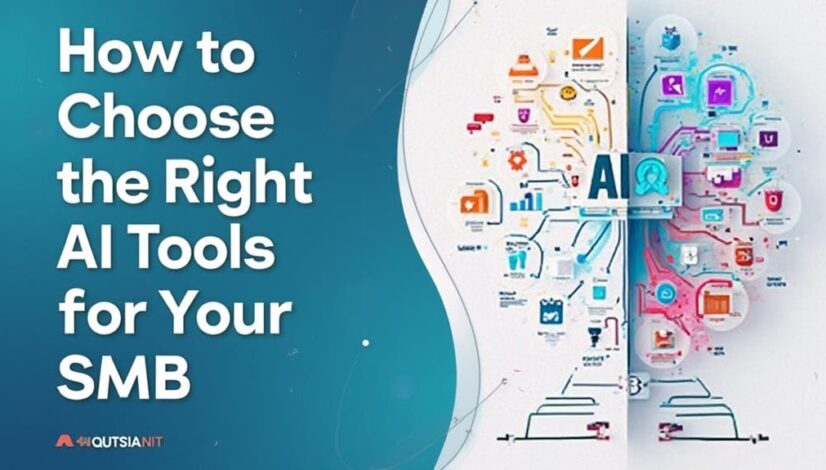How to Choose the Right AI Tools for Your SMB
To choose the right AI tools for your small or medium-sized business (SMB), start by evaluating your specific business needs and objectives. Engage stakeholders to identify areas for improvement, and set a defined budget that includes upfront and ongoing costs. Research available tools by comparing features, scalability, and ease of integration with your existing systems. Prioritize user-friendly interfaces to guarantee quick adoption among employees. Additionally, gather insights from user feedback and competitor analysis to make informed decisions. By strategically considering these factors, you can find tools that will optimize your operations and drive growth—there's much more to discover.
Key Takeaways
- Assess your specific business needs and align AI tools with desired outcomes for improved efficiency and collaboration.
- Establish a budget that includes initial costs and expected ROI to guide investment decisions.
- Research available AI tools, focusing on categories that match your objectives and ensure compatibility with existing systems.
- Evaluate the ease of use of tools to ensure quick adoption and minimal training for employees.
- Seek user feedback and competitor insights to identify effective tools that meet your business requirements.
Assess Your Business Needs

As you commence on the journey of selecting AI tools for your small or medium-sized business (SMB), it is essential to first assess your specific business needs. This foundational step helps to guarantee that any technology you consider aligns with your business objectives and drives meaningful outcomes. A thorough evaluation empowers you to identify gaps and opportunities within your organization, creating a roadmap for how AI can enhance your operations.
Begin by engaging key stakeholders—understanding their perspectives can illuminate significant areas where AI might release efficiency. For example, if your goal is to enhance team collaboration, look for AI tools that facilitate communication and project management, enabling your team to work together seamlessly. Involving those who will use the tools also fosters a sense of ownership and acceptance, fueling successful implementation.
Additionally, prioritize your business objectives. Is your focus on streamlining processes, improving customer service, or elevating data analysis capabilities? Tailoring your AI tool search to these specific objectives not only saves time but also enhances the likelihood of selecting solutions that truly resonate with your operational needs.
Set a Budget
With a clear understanding of your business needs in hand, the next essential step is to establish a budget for your AI tool investments. Setting a financial framework not only streamlines the decision-making process but also guarantees that you make informed choices that align with your overall business strategy.
To begin, perform a thorough cost analysis of the AI tools available in the market. Investigate not just the initial purchase price, but also consider recurring expenses such as subscriptions, maintenance, and training.
Establishing precise ROI expectations is critical. Determine what you hope to achieve from your AI investment; whether it's improved efficiency, enhanced customer experience, or increased sales, your ROI should be measurable. For instance, if deploying AI results in significant time savings, quantify how that time translates into cost savings or additional revenue generation over time.
Moreover, it's wise to create a tiered budget that accommodates both basic tools and advanced analytics. This flexible approach allows your organization to start small and scale as needs evolve and your understanding of AI deepens.
Keep in mind the potential long-term benefits; successful integration of AI can empower your small or medium-sized business to compete with larger entities, guaranteeing greater independence in your market sector.
Ultimately, establishing a prudent budget not only safeguards your financial health but also sets the stage for successful AI implementation, allowing your business the freedom to innovate and thrive.
Research Available Tools

Diving into the world of AI tools can be overwhelming, given the plethora of options available for small and medium-sized businesses (SMBs). To navigate this landscape effectively, it is vital to categorize your options and conduct extensive research. Understanding the various AI tool categories will help you identify which solutions align best with your business needs.
When researching available tools, consider the following aspects:
- Functionality: Identify specific AI tool categories such as automation, analytics, customer support, or marketing. Pinpoint tools that specialize in the areas you want to enhance within your business.
- Integration Capabilities: Evaluate how well the tools integrate with your existing systems. Seamless integration saves time and effort, allowing for more efficient operations.
- Scalability: Choose tools that can grow with your business. As you expand, adaptable AI solutions will guarantee you don't have to repeatedly switch platforms, preserving your investment.
Conducting a thorough tool comparison is essential. Utilize online reviews, comparison websites, and user testimonials to gather insights.
Explore demos or trial versions, enabling you to assess the user experience firsthand. By rigorously researching the available AI tools, you give your SMB the freedom to thrive in a technology-driven market.
This informed approach not only empowers you to select the right tool but also paves the way for innovation and growth, positioning your business at the forefront of industry advancements.
Evaluate Ease of Use
An essential consideration when selecting AI tools for your SMB is evaluating their ease of use. The user interface (UI) of an AI tool greatly impacts user experience (UX), determining how effortlessly your team can integrate the technology into their daily workflows. Intuitive design guarantees that employees do not need extensive training to adapt, facilitating a smoother change and quicker adoption across your organization.
Look for AI tools that feature clear navigation, logical layouts, and responsive design. A well-designed user interface can enhance productivity, freeing your team to focus on their actual tasks rather than getting bogged down in technological complexities. This ease of use can empower your staff, allowing them to fully harness the potential of the AI tools at their disposal.
Additionally, feedback from potential users within your organization is invaluable. Their insights can highlight challenges or preferences that you may not have considered. Conducting trials or demos can also provide firsthand experience of how user-friendly a tool truly is.
Ultimately, the right AI tool should simplify tasks rather than complicate them, giving your SMB the freedom to innovate and grow without the frustration of cumbersome technology.
Prioritizing ease of use in your selection process not only minimizes barriers to implementation but also enhances employee satisfaction and productivity. By investing in user-centric AI tools, you are not just adopting technology; you are fostering an environment where your team can thrive.
Consider Scalability and Integration

Following the selection of AI tools that prioritize ease of use, the next important consideration is scalability and integration. As your small to medium-sized business (SMB) evolves, having the ability to adapt and grow with your chosen AI solutions is paramount.
Opting for tools that are versatile in their cloud capabilities guarantees not only exceptional utilization today but also future growth potential.
When evaluating scalability and integration, consider the following:
- Adaptability: Confirm that the AI tools you choose can accommodate changes in your business size and needs. Look for solutions that can seamlessly integrate additional features without requiring a complete overhaul.
- Interoperability: Your AI tools should work harmoniously with your existing systems, allowing for smooth data transfer and collaboration across platforms. This reduces friction and maximizes the overall efficiency of your operations.
- Cost-Effectiveness: Select solutions that offer tiered pricing based on usage. This strategy allows you to invest in resources that align with your current needs while providing the flexibility to scale as your business grows.
Seek User Feedback and Reviews
To guarantee the chosen AI tools align with the unique needs of your SMB, it is essential to seek user feedback and reviews.
Identifying key user needs will guide your selection process, while analyzing competitor insights can reveal what works effectively in your industry.
Additionally, exploring online platforms for authentic reviews will provide a clearer picture of the tools' capabilities and user satisfaction.
Identify Key User Needs
Understanding key user needs is essential for SMBs looking to effectively integrate AI tools into their operations. Identifying these needs guarantees that the tools selected truly serve the intended purpose and align with user expectations.
One impactful method to attain this knowledge is through the development of user personas. These detailed representations of your target audience help illuminate pain points and preferences.
Consequently, consider the following steps for effective problem identification:
- Conduct Surveys and Interviews: Gather insights directly from users about their experiences and expectations regarding current tools.
- Analyze Usage Patterns: Examine how existing solutions are employed and where bottlenecks occur, which reveals critical areas for improvement.
- Gather User Reviews: Analyze feedback from peers who have used the tools you're considering; they can provide real-life implications and result comparisons.
Analyze Competitor Insights
Having identified key user needs through targeted research, the next step involves analyzing competitor insights to further refine tool selection. Conducting a thorough competitor analysis allows you to gauge market trends and understand how rival businesses leverage AI tools. This understanding is essential in shaping your decision, ensuring that you select tools that not only meet your immediate needs but also position your SMB advantageously within the market.
Dive into user feedback and reviews of your competitors' tools to extract valuable insights. What aspects do users praise, and what pain points do they highlight? This feedback can illuminate potential pitfalls to avoid, as well as features that can elevate your own offerings.
Additionally, evaluating competitor performance against established market trends will enable you to identify best practices and emerging innovations.
Explore Online Platforms
While selecting the right AI tools for your SMB, exploring online platforms for user feedback and reviews becomes essential to make informed choices. Engaging with the experiences of others not only saves time but aids in deciphering the complexities of AI platform comparisons.
Consider these vital aspects when delving into user feedback:
- User Community Forums: Participate in discussions to gauge sentiments about different platforms, their vendor support options, and common issues faced by users.
- Integration Case Studies: Reviewing real-world application cases allows you to evaluate how well a tool integrates with your existing systems and can inform your feature prioritization methods.
- Trial Period Evaluations: Many platforms offer trial periods; use this opportunity to assess platform security features, performance, and ease of use before committing.
Utilizing online tool directories can further streamline your search for reliable reviews. In doing so, make sure that you prioritize user feedback that highlights the effectiveness of the AI tools in meeting the specific needs of your business.
The insights gained will empower you to make a confident, freedom-oriented decision tailored for your SMB's growth.
Frequently Asked Questions
How Do I Determine if My Business Is Ready for AI Tools?
Determining if your business is ready for AI tools requires a thorough AI readiness assessment. Evaluate your current technological infrastructure, data quality, and specific business needs.
Additionally, consider your team's capability and willingness to embrace change through employee training. Investing in training guarantees employees are equipped to leverage AI effectively, fostering a culture of innovation.
Ultimately, aligning your strategic goals with the potential of AI will facilitate a seamless integration process and enhance operational efficiency.
What Common Mistakes Should I Avoid When Choosing AI Tools?
When selecting AI tools, avoid common pitfalls such as neglecting vendor credibility, which can jeopardize the reliability of solutions.
Be wary of integration challenges that may disrupt existing systems, and make certain user training is prioritized to maximize adoption.
Additionally, carefully consider cost implications and scalability potential to avoid financial strain.
Can AI Tools Replace Employees in My Smb?
Imagine a well-tuned orchestra, where each instrument plays its part harmoniously.
AI tools, rather than replacing employees, serve as formidable allies, enhancing productivity through employee augmentation. Embracing these tools bestows numerous benefits, streamlining tasks and amplifying creativity.
While some roles may evolve, the goal is not to substitute human talent but to liberate individuals, allowing them to focus on strategic initiatives that foster innovation and growth within their small to medium-sized businesses.
What Industries Benefit Most From Adopting AI Tools?
Industries that substantially benefit from AI adoption include healthcare, where analytics enhances patient outcomes.
Retail benefits through automation that streamlines operations.
Manufacturing optimizes processes for efficiency.
Financial services leverage AI for precise forecasting, while customer service gains from intelligent chatbot solutions.
Marketing personalization drives targeted engagement, logistics management guarantees smooth operations, and cybersecurity solutions bolster defenses against threats.
These sectors can harness AI's transformative capabilities to attain greater operational freedom and enhanced performance.
How Often Should I Reevaluate My AI Tool Choices?
Regular reevaluation of your AI tool choices is essential to guarantee peak tool performance.
Aim to conduct an appraisal at least once every quarter. This frequency allows you to identify any shifts in your operational needs, emerging technology trends, or changes in the competitive landscape.
Continually evaluating performance not only maximizes efficiency but also empowers your business to adapt and thrive, ensuring that your tools remain aligned with your strategic objectives and freedom to innovate.
Conclusion
The meticulous selection of AI tools for small and medium-sized businesses resembles planting seeds in fertile soil, requiring careful consideration of needs, budget, and potential for growth. Each tool represents a sapling that must thrive in an ecosystem of integration and scalability. User feedback serves as the rain nourishing this growth, ensuring that the enterprise flourishes amidst competition. Ultimately, choosing the right AI tools cultivates innovation, allowing businesses to bloom and reach new heights in an ever-evolving landscape.




